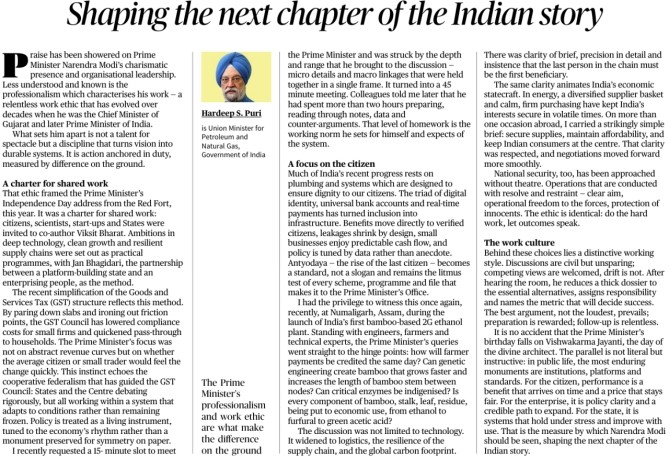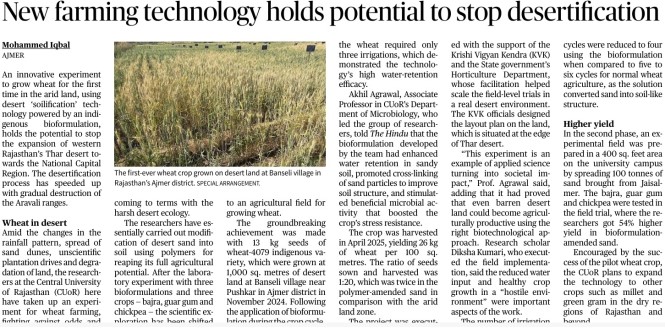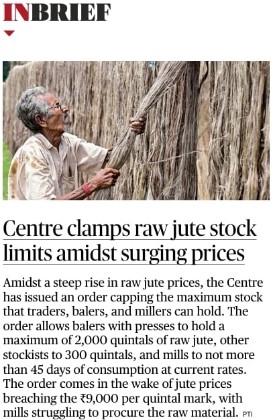Daily CA for UPSC 27th Sep 2025


| Index |
| S.No | Topic |
|
| Daily Hindu Analysis |
| 1. | Shaping the Next Chapter of the Indian Story |
|
| 2. | A Balanced Approach on Firecrackers Needed |
|
| 3. | New Farming Technology Holds Potential to Stop Desertification |
|
| 4. | Centre Clamps Raw Jute Stock Limits Amidst Surging Prices |
|
| 5. | Trump Slaps Tariffs on Drugs, Trucks, Furniture |
|
|
| 6. | Coffee Board of India |
|
| 7. | India’s Dugong Conservation Reserve |
|
| 8. | Financial Intelligence Unit-India | |
| 9. | Forum for India-Pacific Islands Cooperation | |
| 10. | Sustainable Mountain Development Summit (SMDS) | |
1. Shaping the Next Chapter of the Indian Story

Syllabus Mapping GS Paper 2 (Governance, Federalism, and Polity); GS Paper 3 (Economy, Inclusive Growth, and Infrastructure).
Context
- The article, by Union Minister Hardeep S. Puri, reflects on Prime Minister Narendra Modi’s leadership style, work ethic, and governance philosophy.
- It highlights the professionalism, discipline, citizen-centric focus, and systemic reforms that have characterized his tenure as Gujarat’s Chief Minister and later as Prime Minister of India.
- The discussion is placed against the backdrop of Independence Day vision statements, GST reforms, energy security, and citizen-centric programmes.
Key Themes and Analysis
1. Leadership Ethic and Governance Approach
- Relentless work ethic: Preparation, detail, and insistence on data-driven decisions.
- Vision to system: Translating broad goals into practical programmes (e.g., GST simplification, cooperative federalism).
- Shared charter for development: Citizens, scientists, start-ups, and states as co-authors of Viksit Bharat.
2. Focus on Citizens - Programmes designed to ensure dignity and inclusion:
- Digital identity (Aadhaar).
- Universal bank accounts (Jan Dhan).
- Real-time payments (UPI).
- Antyodaya principle: The last citizen becomes the litmus test for every scheme.
- GST reforms: Lower compliance burden, quicker pass-through benefits, cooperative federalism.
3. Economic Governance - Diversified energy basket: Strategic clarity in energy security with multiple suppliers.
- Economic diplomacy: Negotiations with emphasis on citizen affordability and supply stability.
- Clean technology and resilient supply chains as national goals.
4. National Security and Statecraft - Restraint with clarity: Security policy framed as precise, citizen-protecting operations.
- Focus on outcomes, not theatre: Operational freedom with discipline and clear goals.
- Civil but unsparing decision-making: Encouraging debate but prioritizing preparation, follow-up, and responsibility.
5. Institutional and Policy Innovations - Cooperative federalism: GST Council as a model of states–centre cooperation.
- Platform-building state: Enabling private enterprise through state-led frameworks (Jan Bhagidari).
- Systemic durability: Building enduring systems and institutions over spectacle.
6. Work Culture - Data-driven decision-making over anecdote.
- Preparation, clarity, and follow-up as governance hallmarks.
- Best argument wins, not the loudest voice – promoting institutional trust and credibility.
Way Forward - Strengthen institutional continuity so that reforms outlast leadership.
- Focus on regional balance in development, ensuring Antyodaya principle is realised nationwide.
- Leverage digital and clean technologies to expand citizen dignity and economic resilience.
- Embed work culture of preparation, responsibility, and follow-up across administrative levels.
UPSC Mains Examine how Prime Minister Modi's citizen-centric governance model, exemplified by reforms in GST and energy security, contributes to cooperative federalism and inclusive economic growth in India. Suggest measures to enhance its scalability for achieving Viksit Bharat by 2047

2. A Balanced Approach on Firecrackers Needed: SC
Syllabus Mapping
GS Paper 2 (Judiciary, Governance); GS Paper 3 (Environment, Conservation, and Economic Development).
Context:
- Challenges with Complete Ban: SC warns that a total ban on firecrackers could open the field for mafia and illegal peddling, drawing parallels to Bihar's mining ban; past experiences indicate such bans are hard to enforce and may not curb pollution effectively.
- Livelihood Concerns: The firecracker industry employs thousands, particularly the poor; a blanket ban would destroy livelihoods without addressing root issues, as observed by CJI Gavai.
- Uniform National Policy Proposal: In the September 12 hearing, the CJI mooted a need for a consistent policy across India on manufacture, sale, and use of firecrackers to ensure equitable air pollution relief, not just for Delhi's "elite."
- Misconception on Air Pollution: Court clarifies that pollution is not an elite issue but severely affects people on the streets, like construction laborers and daily wagers, as highlighted by amicus curiae Aparajita Singh.
- Industry Grievances: Firecracker manufacturers' licenses (some valid till 2028) are being revoked due to the April 2025 Delhi-NCR ban; they seek relief to continue operations.
- Directive to Environment Ministry: Bench instructs the ministry to consult stakeholders and find a balanced solution that weighs air pollution control against economic impacts.
- Conditional Allowance for Green Crackers: Certified manufacturers can resume production but must undertake not to sell in prohibited areas until further orders; this aims to sustain the industry while prioritizing environmental concerns.
- Previous Delhi-NCR Ban: In April 2025, SC imposed a permanent ban on sale, production, and manufacture in Delhi-NCR, deeming it essential for citizens' right to clean air.
Green Crackers: An Eco-Friendly Alternative
- Green crackers, also known as eco-friendly or low-emission firecrackers, were introduced in India as a response to growing air pollution concerns, particularly during festivals like Diwali.
- Developed by the Council of Scientific and Industrial Research-National Environmental Engineering Research Institute (CSIR-NEERI) in collaboration with the Petroleum and Explosives Safety Organisation (PESO), they are designed to reduce harmful emissions by up to 30% compared to traditional firecrackers.
- CSIR develops Less Polluting Firecrackers named –
- Swas( safe water release)
- Star (safe thermite cracker )
- Safal ( safe minimal aluminium
Key features include: - Reduced Harmful Chemicals: They avoid toxic substances like barium nitrate, lead, and arsenic, which are common in conventional crackers and contribute to particulate matter (PM2.5 and PM10) pollution.
- Emission Control Mechanisms: Formulated with smaller shell sizes, water-based releasers, and additives like dust suppressants to minimize airborne pollutants and noise levels (typically 125-130 decibels, lower than traditional ones).
- Identification: Genuine green crackers bear a distinctive green logo from CSIR-NEERI and PESO, along with a Quick Response (QR) code for verification; they are certified for lower sulfur dioxide, nitrogen oxide, and particulate emissions.
- Environmental Benefits: Aimed at curbing festival-related air quality deterioration, they promote sustainable celebrations without fully eliminating cultural practices.
- Regulatory Context: In the SC ruling, only manufacturers certified by NEERI and PESO for green crackers are allowed to operate, reflecting the Court's push for pollution mitigation through innovation rather than outright prohibition.
- However, challenges include higher production costs, limited availability, and enforcement issues to prevent mixing with banned conventional crackers.
Analysis - Judicial Balancing of Rights: The SC's shift from a complete ban (April 2025) to conditional allowances underscores the need to balance Article 21 (right to clean air and life) with Article 19(1)(g) (right to occupation), preventing overreach that could foster illegal activities while protecting public health.
- Socio-Economic Implications: By highlighting livelihood losses for the poor in the firecracker sector, the ruling aligns with inclusive growth principles; however, it necessitates skill development and alternative employment to transition workers from polluting industries, addressing inequities where pollution disproportionately affects marginalized groups like daily wagers.
- Federal and Policy Uniformity: The call for a national policy promotes cooperative federalism (under Articles 246-263), ensuring states like Delhi-NCR aren't isolated; this could standardize regulations but requires inter-state coordination to avoid disparities in enforcement.
- Environmental Sustainability and Innovation: Allowing green crackers encourages technological advancements (e.g., NEERI-PESO certifications) for low-emission alternatives, supporting India's commitments under the Paris Agreement and National Clean Air Programme (NCAP); yet, effectiveness depends on strict monitoring to curb non-compliance and black-market sales.
- Stakeholder Consultation: Directing the Environment Ministry to hear all parties (manufacturers, sellers, citizens) exemplifies participatory governance, potentially leading to evidence-based policies; risks include delays if consultations prolong, exacerbating pre-festival pollution spikes.
- Broader Pollution Context: The ruling exposes misconceptions about pollution as an "elite" issue, urging holistic measures like vehicle emission controls and stubble burning alternatives; long-term, it could integrate with urban planning for resilient cities amid climate change.
UPSC Mains Q. Critically analyze the Supreme Court's evolving stance on firecracker regulations in India, with special reference to the balance between environmental protection, livelihoods, and cultural practices. Discuss the role of green crackers in achieving sustainable festive celebrations.
3. New Farming Technology Holds Potential to Stop Desertification

Context
- Researchers at the Central University of Rajasthan (CUoR) have developed an innovative farming experiment using ‘soilification’ technology powered by an indigenous bioformulation.
- This technique enabled wheat cultivation for the first time in the desert lands of Ajmer district (Thar Desert fringe).
- It holds the potential to halt desertification, which has accelerated due to destruction of the Aravali ranges, erratic rainfall, and spread of sand dunes.
Technology and Methodology: The bioformulation, developed CUoR's Department of Microbiology, incorporates polymers along with bio-materials derived from bajra (pearl millet), guar gum, and chickpea. These elements promote cross-linking of sand particles, improving soil structure, stability, and microbial activity. The process involves modifying desert sand (sourced from Jaisalmer) by reaping its full agricultural potential. After laboratory experiments with three bioformulations, the team shifted to an on-field application in Banseli village, Pushkar, Ajmer district. Key innovation: The technology requires only three irrigations per crop cycle (compared to four to five in normal wheat agriculture), due to its high water-retention efficiency. This is achieved by boosting the crop's stress resistance through groundwater-breaking mechanisms.
Pilot Project Execution and Results: · The project was executed with support from the
Krishi Vigyan Kendra (KVK) and the State Government's Horticulture Department, scaling from field-level trials in a real desert environment. · In the first phase (April 2025 harvest): 13 kg seeds of wheat-4079 indigenous variety were sown on 100 sq. meters of polymer-amended sand, yielding 26 kg— a sown-to-harvested ratio of 1:20, twice the normal 1:10 in arid zones. · In the second phase: An experimental field was prepared in a 400 sq. feet area by spreading 100 tonnes of sand brought from Jaisalmer. The bioformulation reduced irrigation cycles to four (from five to six normally) and enhanced soil structure into soil-like consistency. · Higher yield: The field yielded 54% higher bioformulation-amended sand, with encouraging results for expanding the technology to other green gram crops in dry regions of Rajasthan and beyond. · It noted the reduced water input and healthy crop growth as "hostile environment" important aspects, emphasizing its potential for millet and other drought-resistant crops.
Scientific and Practical Implications: · The technology addresses core challenges of desert farming: rainfall patterns, spread of sand dunes, unscientific plantation drives, and land degradation. · By fighting against odds like harsh desert ecology, it promotes cross-linking for soil promotion, turning sandy, non-productive land into agriculturally viable areas. · The reduced water requirement (e.g., sown and harvested wheat per 100 sq. meters at Banseli) makes it groundbreaking, as it was the first-ever wheat crop grown on desert sand at Banseli village
. UPSC value addition Environmental Significance:
- Combating Land Degradation: Aligns with India's UNCCD commitments and the goal of land degradation neutrality by 2030. The technology prevents soil erosion and dune expansion in Rajasthan, where 20% of India's land is degraded (as per ISRO's Desertification Atlas).
- Climate Resilience: By enhancing water retention and reducing irrigation needs, it mitigates climate change impacts like droughts, supporting India's Nationally Determined Contributions (NDCs) under the Paris Agreement.
- Biodiversity Promotion: Indigenous bio-materials (bajra, guar, chickpea) foster microbial diversity, aiding ecosystem restoration in fragile arid zones.
- Agricultural Implications:
- Sustainable Farming Practices: Reduces dependency on water-intensive crops, promoting drought-resistant varieties like wheat-4079, which can integrate with schemes like Pradhan Mantri Krishi Sinchayee Yojana (PMKSY) for efficient water use.
- Yield Enhancement and Scalability: The 54% higher yield in amended sand highlights potential for increasing food production in non-arable lands, addressing India's food security challenges amid a growing population.
Technological Innovation: o Represents biotechnology's role in agriculture, similar to GM crops or nano-fertilizers, but focused on soil health—crucial for the Soil Health Card Scheme.
- Economic and Social Dimensions:
- Livelihood Generation: Benefits rural communities in desert areas by enabling farming on degraded land, reducing migration and poverty, in line with MGNREGA's focus on land restoration.
- Cost-Effectiveness: Lower irrigation cycles cut water and energy costs, making it viable for small farmers; however, initial bioformulation costs need subsidization.
- Regional Development: Targets Rajasthan's economy, where agriculture contributes 25% to GSDP despite arid conditions, potentially boosting exports of millets and pulses.
- Policy and Governance Relevance:
- Institutional Support: Involves collaboration between universities (CUoR), KVKs, and state departments, exemplifying cooperative federalism (Article 246, Schedule VII).
- Alignment with Schemes: Complements initiatives like Desert Development Programme (DDP), Integrated Watershed Management Programme (IWMP), and Atal Bhujal Yojana for groundwater recharge.
- Global and Comparative Perspective:
- Similar to Israel's drip irrigation or China's Great Green Wall, this could position India as a leader in desert reclamation. Challenges include intellectual property rights for bioformulations and international collaborations under UNCCD.
UPSC Prelims Q. With reference to the bioformulation technology for combating desertification in India, consider the following statements: 1. It involves the use of polymers and indigenous bio-materials like bajra and guar gum to convert desert sand into arable soil. 2. The technology was developed by the Indian Council of Agricultural Research (ICAR) and tested in the Thar Desert region. 3. It reduces the number of irrigation cycles required for wheat cultivation compared to conventional methods. Which of the statements given above is/are correct? (a) 1 only (b) 1 and 3 only (c) 2 and 3 only (d) 1, 2 and 3 Answer: (b) 1 and 3 only
4. Centre Clamps Raw Jute Stock Limits Amidst Surging Prices 
Syllabus Mapping: GS Paper 3 (Economy - Agriculture Marketing, Food Processing Industries; Indian Economy - Issues relating to mobilization of resources).
Context
- The Government of India has imposed stockholding limits on raw jute amidst a steep surge in prices.
- Traders, balers, and millers now face restrictions on how much raw jute they can store.
- This move comes as raw jute prices breached ₹9,000/quintal, severely affecting mills’ ability to procure raw material.
Core Content 1. The Order - Baler presses: Maximum 2,000 quintals of raw jute.
- Other stockists: Maximum 300 quintals.
- Mills: Stock limit not more than 45 days of consumption at current rates.
2. Reasons Behind the Move - Price Surge: Raw jute prices have risen sharply, leading to shortages for mills.
- Speculative Hoarding: Traders and intermediaries suspected of artificially inflating prices.
- Mills Under Stress: Jute mills, especially in West Bengal, face difficulties in production due to high input costs.
3. Implications - For Farmers: Price rise could benefit jute growers in the short term, but long-term instability may hurt demand.
- For Mills: Stock limits ensure smoother procurement, but high prices continue to hurt margins.
- For Consumers & Industry: Jute is essential for packaging (especially food grains & sugar); rising costs impact inflation and supply chains.
- For Government: Jute packaging is mandatory under the Jute Packaging Materials (Compulsory Use in Packing Commodities) Act, 1987 → limits are needed to balance industry sustainability.
4. Broader Relevance - Economy: Reflects the tension between farmer welfare (higher prices) and industrial stability (affordable raw material).
- Agriculture: Jute is a major cash crop in West Bengal, Assam, Bihar, Odisha.
- Policy Tool: Stockholding limits are part of Essential Commodities Act mechanisms used to check inflation and hoarding.
- Sustainability Angle: Jute is an eco-friendly alternative to plastics → stability of the sector crucial for environmental goals.
UPSC Value Addition - Jute Bag Rules: Under the Jute Packaging Materials (Compulsory Use in Packing Commodities) Act, 1987, the government mandates jute bags for packaging to promote the sector and reduce plastic waste.
- As of April 2025, 100% of foodgrains and 20% of sugar production must use jute bags, extended by Cabinet approval till December 31, 2025.
- The Karnataka High Court upheld this in September 2025, dismissing challenges from sugar mill associations, emphasizing environmental benefits and farmer welfare.
- This integrates with the Plastic Waste Management Rules, 2016 (amended 2022), positioning jute as an eco-alternative, though enforcement gaps persist due to higher costs (jute bags 20% pricier than polypropylene).
- Jute, a water-intensive kharif crop, thrives in West Bengal's alluvial floodplains, particularly around ox-bow lakes (U-shaped meanders cut off from rivers like the Ganges).
- These lakes, numbering over 120 in Nadia district alone, provide stagnant water ideal for retting (soaking stems to separate fibers), a critical post-harvest process.
- However, retting pollutes lakes with biochemical oxygen demand (BOD) spikes, harming aquatic ecosystems and phytoplankton diversity in sites like Chhariganga Oxbow Lake.
- Over 68% of local households depend on these lakes for fishing and irrigation, highlighting trade-offs in sustainable cultivation.
- Initiatives like microbial retting under Jute ICARE scheme aim to mitigate pollution.
Other Relevant Information - Economic Profile: India produces 1.5 million tonnes of jute annually (2024-25 estimate), exporting 3-4 lakh bales mainly to Bangladesh and the EU for eco-friendly textiles. The sector's GDP contribution is ~0.1%, but it sustains 40,000 looms in mills.
- Government Interventions: Beyond stock limits, the Jute Technology Mission promotes diversified uses (e.g., geotextiles), while the ₹500 crore Jute Integrated Capital Assistance & Retting (Jute ICARE) scheme (2020) funds sustainable farming. MSP procurement by JCI covers 20-25% of output.
- Global Context: Bangladesh dominates exports (80% share), but India's push for value-added products like jute handicrafts could capture premium markets. Climate change exacerbates risks, with projections of 10-15% yield loss by 2030 without adaptation.
- Forward Linkages: Surging prices may inflate costs for FCI (foodgrain packaging), indirectly affecting PDS subsidies, underscoring jute's role in food security.
UPSC Prelims Q. With reference to the recent stock limits imposed on raw jute in India (September 2025), consider the following statements:
1. The maximum stock limit for balers with presses is 2,000 quintals, while mills are restricted to 45 days of consumption.
2. The order was issued under the Jute Packaging Materials Act, 1987.
3. Raw jute prices have surged beyond ₹9,000 per quintal due to lower production and hoarding.
Which of the statements given above is/are correct? (a) 1 only (b) 1 and 3 only (c) 2 and 3 only (d) 1, 2 and 3
Answer: (b)


Syllabus Mapping: GS Paper 3 (Economy - Indian Economy and issues relating to planning, mobilization of resources; Agriculture - Major crops-cropping patterns; Effects of liberalization on the economy).
Context
- U.S. President Donald Trump has announced a new round of punitive tariffs on a wide range of imported goods into the United States.
- The tariffs include:
- 100% duty on branded/patented pharmaceutical products.
- 25% duty on heavy-duty trucks (major exporters: Mexico, Canada, Japan, Germany, Finland).
- 30–35% duty on household furniture, including kitchen cabinets and bathroom vanities.
- Trump justified the move as a response to the “large-scale flooding” of such goods into the U.S. by other countries, portraying it as a measure to protect U.S. manufacturers from “unfair outside competition.”
- The measures reflect the Trump administration’s broader strategy of using tariffs as a foreign policy tool, to renegotiate trade deals, extract concessions, and exert pressure on other nations.
- The move comes against the backdrop of earlier U.S. national security tariffs on steel, aluminium, autos, and copper, and amidst ongoing trade tensions with allies and competitors alike.
India's Pharmaceutical Landscape:
- The 100% tariff on branded drugs targets major exporters, hitting India's $8-10 billion annual U.S. exports (40% of U.S. generics). This could disrupt supply chains for essential medicines, raising U.S. prices by 20-30% and prompting relocations, though exemptions for U.S.-built plants favor multinationals over Indian firms.
- India, dubbed the "pharmacy of the world," is the third-largest producer of drugs by volume (behind China and the U.S.) and the largest provider of generic medicines globally, holding a 20% share in global generics supply by volume and manufacturing around 60,000 generic brands.
- Per the Economic Survey 2024-25, India's pharma market is valued at ~US$58 billion (FY24), projected to reach US$130 billion by 2030, contributing 1.7% to GDP.
- It supplies 40% of the U.S. generic drug market and 25% of all medicines in the UK, with exports at US$27.85 billion in FY24 (up 10%).
- Notably, 8 of the top 20 global generic companies are Indian (e.g., Sun Pharma, Dr. Reddy's), underscoring India's volume leadership—third globally by volume but 13th by value due to low pricing.
Atmanirbhar Bharat Initiatives in Pharma The Economic Survey 2024-25 highlights self-reliance drives under Atmanirbhar Bharat, with the Production Linked Incentive (PLI) Scheme for Bulk Drugs (2020-25, ₹6,940 crore outlay) promoting domestic API production to reduce import dependence from 70% (mostly China) to 50% by 2025. o Key outcomes include 50+ greenfield projects for critical APIs like penicillin and vitamins, creating 50,000 jobs. o The Pradhan Mantri Jan Aushadhi Yojana (PMJAY) has expanded to 13,000+ Kendras, dispensing affordable generics at 60-90% discounts, serving 10 crore beneficiaries and saving ₹25,000 crore in out-of-pocket expenses. o These align with the National Pharma Policy 2023, aiming for US$120 billion exports by 2030 through tech parks and R&D hubs. Challenges in the Pharma Sector o Despite strengths, vulnerabilities persist: India imports 60-70% of APIs (valued at US$5-6 billion annually, 80% from China), exposing supply chains to geopolitical risks like U.S. tariffs. o Low R&D investment (0.3-1% of sales vs. global 10-15%) hampers innovation in branded drugs, with only 2% of global patents from India. o Technology gaps in biologics and advanced manufacturing, coupled with regulatory hurdles (e.g., USFDA compliance costs), limit value addition. o The Economic Survey 2024-25 notes skill shortages (need for 2 lakh pharma professionals by 2030) and pricing pressures under National List of Essential Medicines, risking export disruptions from tariffs. Broader Trade and Economic Implications o Trump's tariffs could collect $300 billion but inflate U.S. inflation by 1-2%, per estimates, while prompting retaliatory duties from India (e.g., on U.S. almonds, apples). For India, they test WTO compliance and US-India BIT negotiations, potentially diversifying exports to ASEAN/ Africa. o Positively, they accelerate Atmanirbhar by incentivizing domestic value chains, but SMEs face 10-15% margin erosion. o Globally, this escalates de-globalization, impacting India's $120 billion merchandise trade surplus. UPSC Prelims Q. With reference to India's pharmaceutical industry, consider the following statements: 1. India holds a 20% share in the global supply of generic drugs by volume and is the third-largest producer by volume. 2. The Production Linked Incentive (PLI) Scheme for Bulk Drugs primarily aims to reduce API imports from China. 3. Eight of the top 20 global generic companies are based in India. Which of the statements given above is/are correct? (a) 1 only (b) 1 and 3 only (c) 2 and 3 only (d) 1, 2 and 3 Answer: (d)
6. Coffee Board of India

Syllabus: GS Paper 3 – Economy / Agriculture & Allied Sectors
Context: The Coffee Board of India is conducting capacity-building programmes to encourage coffee growers to register on its mobile application for
EU Deforestation Regulation compliance, promoting sustainable coffee production.
Key Points: - Constitution: Statutory body under Section 4 of the Coffee Act, 1942.
- Board Members: 33 members representing the coffee industry, nominated by the central government for 3-year terms.
- Additional Members: 32 members appointed as per Section 4(2) of the Coffee Act & Rule 3 of the Coffee Rules, 1955.
- Functions: Focus on research, extension, development, market intelligence, promotion (domestic & international), and welfare measures for growers.
- Nodal Ministry: Operates under the Ministry of Commerce and Industry, Government of India.
- Head Office: Located in Bangalore, Karnataka.
- Recent Initiative: Capacity-building programmes to increase grower registration on the Coffee Board mobile app for EU deforestation compliance.
Source: PIB

7. India’s Dugong Conservation Reserve
Syllabus: GS Paper 3 – Environment and Biodiversity
Context: India’s first Dugong Conservation Reserve in Palk Bay has been formally recognized by the IUCN, highlighting efforts to protect marine biodiversity, especially the vulnerable dugong species.
Key Points:
- Established: September 21, 2022, by Tamil Nadu under the Wildlife Protection Act, 1972.
- Area Covered: 448.34 sq. km in northern Palk Bay.
- Seagrass Meadows: Over 12,250 hectares, crucial for dugong feeding and supporting other marine species.
- Dugong Species: Dugong dugon, the only herbivorous marine mammal in India.
- Appearance: Resembles a cross between a seal and a whale; also called the sea cow.
- Distribution: Found along Indian coasts – Andaman & Nicobar Islands, Gulf of Mannar, Palk Bay, Gulf of Kutch.
- Habitat: Shallow waters with seagrasses of genera Cymodocea, Halophila, Thalassia, and Halodule.
- Reproduction: Maturity at 9–10 years; calving every 3–5 years; slow population growth (~5% per year).
- Conservation Status:
- IUCN: Vulnerable
- CITES: Appendix I
- Wildlife Protection Act 1972: Schedule I
Source: The Indian Express
8. Financial Intelligence Unit-India
Syllabus: GS Paper 3 – Economy / Security and Intelligence
Context: The Department of Telecommunications (DoT) and FIU-IND signed an MoU to
enhance data sharing and inter-agency coordination, strengthening India’s financial intelligence ecosystem.
Key Points:
- Established: 2004 by the Government of India.
- Role: Central agency for receiving, processing, analyzing, and disseminating information on suspicious financial transactions.
- Reporting: Independent body reporting to the Economic Intelligence Council (EIC) headed by the Finance Minister.
- Information Collection: Receives Cash Transaction Reports (CTRs), Non-Profit Organisation Reports (NTRs), Cross Border Wire Transfer Reports (CBWTRs), Immovable Property Reports (IPRs), and Suspicious Transaction Reports (STRs).
- Analysis: Identifies patterns suggesting money laundering and related crimes.
- Information Sharing: Shares data with national law enforcement, regulatory authorities, and foreign FIUs.
- Central Repository: Maintains a national database based on reports from reporting entities.
- Coordination: Strengthens collection and sharing of financial intelligence nationally, regionally, and globally.
- Research & Analysis: Monitors trends, typologies, and developments in money laundering.
Source: DD News
9. Forum for India-Pacific Islands Cooperation
Syllabus: GS Paper 2 – International Relations / India & its Neighbourhood
Context: India hosted a meeting of FIPIC foreign ministers in New York, reaffirming its commitment to strengthen ties with Pacific Island countries under the Act East Policy.
Key Points:
- Establishment: 2014, during the Prime Minister’s visit to Fiji.
- Purpose: Multilateral platform to enhance cooperation with Pacific Island countries.
- Member Countries (14): Cook Islands, Fiji, Kiribati, Marshall Islands, Micronesia, Nauru, Niue, Palau, Papua New Guinea, Samoa, Solomon Islands, Tonga, Tuvalu, Vanuatu.
- Economic Cooperation: Total annual trade ~$300 million; exports ~$200 million, imports ~$100 million.
- FIPIC Summits: 1st – 2014 (Suva, Fiji), 2nd – 2015 (Jaipur, India), 3rd – 2023 (Port Moresby, Papua New Guinea).
- Key Initiatives
- Special USD 1 million fund for climate change adaptation and clean energy.
- Trade office established in India for Pacific Islands.
- Pan Pacific Islands e-network for digital connectivity.
- Visa on arrival at Indian airports for all 14 countries.
- Cooperation in space technology applications.
- Training programs for diplomats from Pacific Island countries.
Source: News On Air
10. Sustainable Mountain Development Summit (SMDS)
Syllabus: GS Paper 3 – Environment / Disaster Management / Ecology
Context: The
12th Sustainable Mountain Development Summit (SMDS-XII) was held at Doon University, Dehradun, focusing on ecological, economic, and social challenges of the
Indian Himalayan Region (IHR).
Key Points:
- Nature: Flagship annual summit addressing ecological, economic, and social challenges of Himalayan regions.
- Platform: Multi-stakeholder forum for dialogue, knowledge sharing, and policy recommendations.
- Organisers: Conducted by the Integrated Mountain Initiative (IMI), a civil society-led network.
- Origin: First summit held in 2011 at Nainital, Uttarakhand (SMDS-I).
- Aim:
- Promote sustainable development in fragile Himalayan ecosystems.
- Strengthen community participation in governance and policy-making.
- Blend scientific knowledge and traditional wisdom for climate resilience.
- Mainstream mountain concerns into India’s national and global development agenda.
Source: TOI








